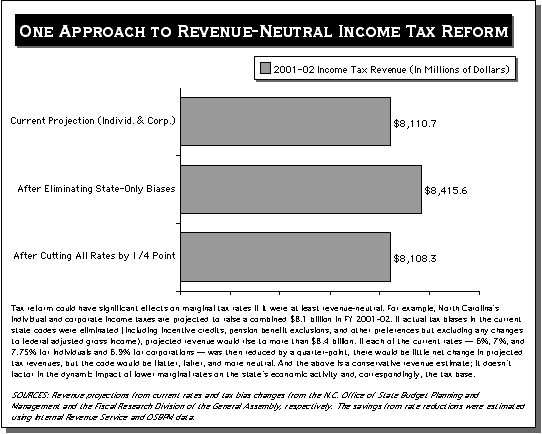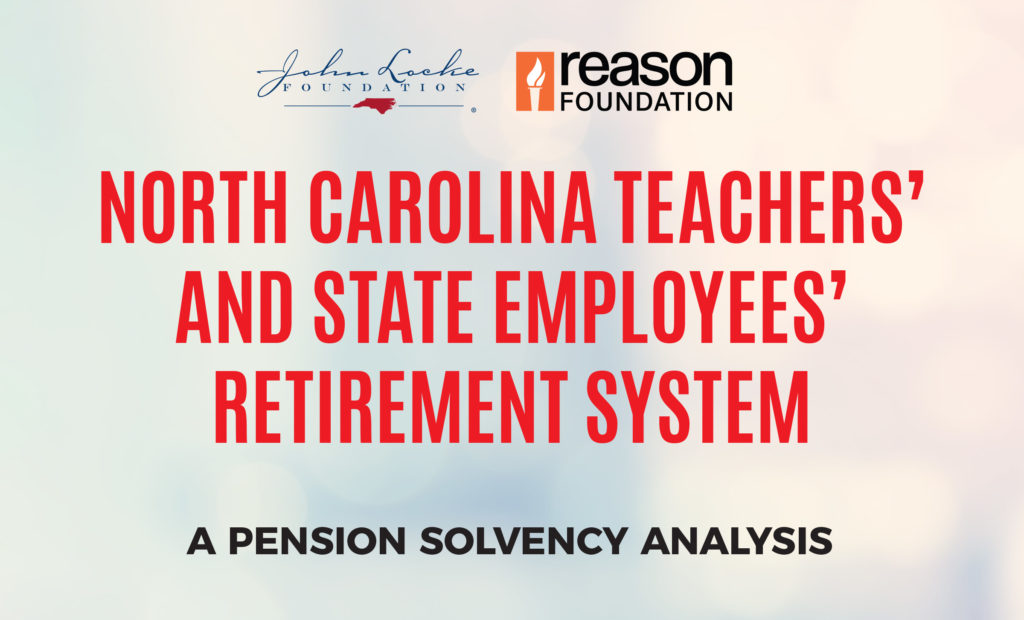Gov. Mike Easley’s preliminary budget for FY 2001-03 calls for the elimination of $150 million in so called “tax loopholes.” He will issue his final recommendations after examining the findings of a commission he appointed to study the issue. But when it comes to assessing these “loopholes,” the governor, his commission, and the N.C. General Assembly’s staff are at sea without a rudder. They have no guiding principles or even a working definition of what a loophole is. Therefore, the governor’s mission and that of the commission lacks coherence and any recommendations it offers will be nothing more than an arbitrary set of tax increases. While these loophole closings might succeed in fattening the state treasury, they certainly will not improve fairness or the efficiency of the state’s tax system.
Tax Biases vs. Tax Loopholes
To aid Easley’s panel and a prior study commission on tax policy, the Fiscal Research Division of the legislative staff issued a list of “tax expenditures” that seem to have only one thing in common: they are an untaxed or differently taxed part of a category of funds or activities that is generally included in the state tax base.1 Examples include the sales tax exemptions for services and for food consumed at home.
On the other hand, not all such exemptions are listed. Inexplicably, the long-standing tax exclusion for the value of employer-sponsored health insurance a large component of worker compensation is not listed. According to the federal budget for FY 2000-01, this exclusion was equal to $81 billion, or 8.3 percent of all federal individual income taxes collected.2 Assuming the same proportional fiscal impact, North Carolina’s tax exclusion for health benefits was worth $622.8 million in FY 2000-01 making it by far the largest “loophole” in the state’s income tax.
Also, when examining differentials in tax rates for similar items within a tax base, the legislative staff assumed that the benchmark is always the higher rate. For example, unfortified wine is taxed at 21 cents per liter and fortified wine is taxed at 24 cents per liter.3 The more highly taxed fortified wine is considered to have the “correct” rate while the less highly taxed unfortified wine is considered to have the” subsidized” rate. But there is no logic to this approach. The difference can just as easily be viewed as a tax penalty being placed on the fortified wine as a “tax expenditure” that favors the unfortified. What this example shows is that since there are no principles guiding the identification of loopholes, any categorization is completely arbitrary. There is never any explanation as to why all loophole closings must automatically result in the higher rate being uniformly imposed rather than the lower rate. Conceptually, either approach would eliminate the loophole.
The concept of tax loopholes embodied in this list is vacuous. The underlying assumption is that any tax base that is taxed should be taxed. The process of identifying loopholes has simply become a mining expedition in search of new revenues.
From the perspective of efficiency and tax fairness there are some forms of income and some activities that should not be taxed in a given year at all because of penalties or biases that are created within the overall structure. These biases result in distortions of the state’s economy and the subsidization of some people’s preferences over others. Exemptions within these categories are often justified because they help to alleviate a penalty. Easley and other state leaders should not simply try to find new ways to tax North Carolina’s citizens but to reform the state’s tax code by identifying and eliminating tax biases.
How to Identify Tax Biases: Some Basic Principles of Tax Policy
The purpose of taxation is to finance government services. In a free society this should be done while exerting as little influence over private sector decision making as possible. There are three main principles that should guide tax reform:
- Simplicity Can taxpayers understand the tax code and reliably predict their tax liability over time?
- Neutrality Does the code create biases in favor of particular taxpayers, regions, or economic decisions?
- Equity Do taxpayers, as much as possible, pay for government in proportion to the benefits they receive?
Tax codes that violate the simplicity principle hide the true cost of government and waste time and resources trying to enforce complex rules that most taxpayers cannot understand without professional assistance (and sometimes even with such help). Tax codes that violate the neutrality principle attempt to use tax policy to guide the personal and economic choices of individuals and businesses. If subsidies for particular behaviors or classes of businesses are justified a big “if’ they should be appropriated in the normal budget process, not tucked away in the tax code.
Dovetailing with the principle of neutrality is equity. In a free society, tax equity is not synonymous with progressivity, as some apparently believe. There is nothing fair or equitable about using taxation to penalize people as they become more productive.4 The values of personal freedom and personal responsibility suggest that, to the extent possible, people’s taxes should reflect the level of government services that they receive. It is fair that people pay for what they get. This is known as the “benefit principle.” It argues for proportionality not progressivity or regressivity in the tax code.
The Income Tax
North Carolina’s income tax dominates state tax collections, raising 56 percent of all tax revenues. By comparison, the sales tax raises only half this amount.5 The income tax penalizes work effort, saving, and investment. This is because it is biased against all income-generating activities relative to those not generating income. It is a well-known principle that if you want to discourage people from doing something such as smoking or purchasing foreign-made products you tax it. Income taxes discourage people from doing those things work, saving, investment which produce goods and services, create employment opportunities, and provide the basis for income and all other taxation.
The way the income tax rate and base are structured can have an important impact on the extent to which the tax will violate the simplicity, neutrality, and equity principles. First, there should be a single rate that applies to everyone and that is kept as low as possible. This will help to minimize the negative impact on both work effort and saving. The tax rate on additional income earned, what is called the marginal tax rate, defines the percentage of each additional dollar that income earners can keep. The more income a person is allowed to keep the more likely it is that he will be willing to pursue earning that income, i.e., be productive. Therefore, the lower the income tax rate the more goods and services North Carolinians will be willing to produce and the more productive our economy will be. Also, the rate should be kept flat, regardless of income, because a rate that rises with income discourages people from increasing their productivity; i.e., from working harder or taking on overtime hours, from gaining additional education, or from seeking out better investment or saving opportunities.
The current income tax also contains an added bias against all forms of saving, including investment. The income tax in both federal and North Carolina law imposes a double tax on the returns to saving. This can be demonstrated with a simple example. Imagine that someone earns an additional $1,000, possibly by working some overtime hours. Without an income tax he could either spend that money and receive $1,000 in value from the purchase of some product or service, or he could invest it at an annual rate of 5 percent and have $1,050 to spend a year from now. He would make his decision about spending the money now or next year based on how he values this tradeoff. If this $1,000 in income is taxed at North Carolina’s lowest rate of 6 percent he is left with $940. If he spends the money now then his consumption will be reduced by 6 percent, from $1,000 to $940. If he saves the money his interest earnings are also reduced by 6 percent, from $50 to $47, making available $987 the next year. His tradeoff in this situation would be $940 now or $987 a year from now. Both his returns to consumption and his returns to savings have been reduced proportionally. The problem is that the $47 is also taxed as interest income. This reduces his return to saving a second time and creates a bias against savings or investment.
The best way to eliminate this bias is to remove all income used for saving from the tax base and tax only income used for current consumption. If the person were not taxed on the $1,000 so long as it was used for saving (which is nothing more than deferred consumption), the bias would be eliminated. He would earn $50 in interest which, like IRA funds, would be taxed when the money is withdrawn from savings and spent. In this example, it would be withdrawn and taxed a year later, reducing it to $47. If he withdraws the entire $1,050, it would be taxed at the 6 percent rate, reducing the amount available for spending to $987. The principal and the returns are only taxed once, when they are used for consumption.
The taxation of business income also needs to be examined. Clearly, all business expenses should be tax deductible. Such expenses are forms of investment. But the current system, which follows federal tax law, does not allow for the full value of all capital equipment and real property purchases to be recuperated. This is because of the write-off system known as capital depreciation. Most equipment purchases and all real property purchases can only be written off over an extended period of time. Because of this, part of the value of the write-off is lost due to the passage of time. This is measured in terms of the interest that could be earned on the full value of the write-off over the depreciation period. In other words, when depreciation is used the full value of the write-off must be discounted by the forgone value on other uses of that money over the relevant time period. This means that there is a current tax bias against investing in capital equipment. To ensure that businesses realize the full value of any equipment or real property write-off, the entire amount of the purchase must be written off in the year that the expenses are incurred. This is known as expensing.
The state should also reduce the biases created by the corporate income tax. The corporate tax is an additional layer of tax on investment. In reality corporations don’t earn income, people do. As such all corporate earnings ultimately are dispersed to shareholders, where they are taxed, or are put back into the company in the form of new investment. In addition, the corporate income tax is a hidden tax paid by shareholders in the form of lower dividends or capital gains, by employees in the form of lower wages, and by consumers in the form of higher prices. But it never appears on a personal income statement, as a deduction from a paycheck, or as an item on a purchase receipt. Because of this, the corporate income tax not only distorts economic decisions, but also subverts the democratic process, hiding government’s true cost from the citizens.
Most of the corporate tax “loopholes” identified by the Fiscal Research Division are in the form of tax credits for favored activities like job creation in specially designated areas, and investment in “renewable energy” and recycling facilities.6 Clearly these benefits to politically favored businesses should be abolished, but with an eye toward reducing the overall burden of the corporate income tax on the state’s economy. In other words there should be at least a dollar for dollar tradeoff by reducing corporate income tax rates for all corporations operating in the state. This would take the government out of the role of picking winners and losers in the market while not increasing the burden on business activity in the state.
The Sales Tax
In principle, using sales as a base eliminates the tax bias against saving and investment. It taxes money used for consumption and exempts funds that go into savings. The current sales tax structure in North Carolina, though, has a number of biases. For example, the state’s exemption of services and food should be reconsidered (but only if the sales tax rate is reduced accordingly and a constitutional barrier placed on raising the rate in the future). On the other hand, no purchases that are used for business purposes should be included. These are not consumption goods. For example the current sales tax has reduced rates for or completely exempts the purchase of railway cars, locomotives, fuel and electricity to farms and manufacturers, and certain farm products sold to manufacturers for further processing, to name a few.7 These differentials and exemptions are listed as “loopholes.” But since all of these are productive inputs and therefore not consumption but investment purchases, they should not be part of the tax base at all. In examining tax biases in the sales tax all such purchases that are currently exempt should remain exempt and those that aren’t should be moved into the exempt category.
Conclusion
The issue state leaders should consider is not the nebulous one of tax loopholes but the more principled concept of tax biases. Changes in the tax code should seek to minimize government influence over personal and economic choices. It should be cautioned though that any move under the current system to remove such biases that lead to tax revenue increases should be offset by generalized reductions in tax rates. There are two reasons for this. First as discussed above, rates should always be kept as low as possible. Second, all transfers of wealth and income from the private sector to the public sector will impinge upon our liberty to pursue our own goals and will therefor alter our decision-making. Any changes from the current system should be done within the context of revenue neutrality or, if possible, revenue reduction. An alternative would be to always couple revenue-raising eliminations of tax biases with offsetting revenue-reducing eliminations of tax biases.
While it is important to examine the basic principles that should guide tax policy, ultimately such discussions cannot be divorced from the role of government. The greater the role of government in society the more revenue needs to be extracted from the private sector via taxation. The specifics of how the reallocation of revenues will affect economic growth and the relative prices of goods and services are unpredictable. But it can be said that the economic well being of North Carolina’s citizens will be enhanced to the extent that resources are allocated by entrepreneurs, investors, and consumers in the private sector. For this reason alone the size of state government should be continuously reassessed and, where possible, be reduced.
Dr. Roy Cordato, Vice President for Research

Notes
- “North Carolina Tax Expenditures,” Fiscal Research Division, North Carolina General Assembly, 2001, pp. 1-9.
- Budget of the United States Government, FY 2001, U.S. Office of Management and Budget, February 7, 2000, p. 249 and p. 407.
- “North Carolina Tax Expenditures,” p. 8.
- See Roy E. Cordato, “Tax Fairness or Moral Bankruptcy?” (Washington, D.C.: The Institute for Research on the Economics of Taxation) September 6, 1991.
- “North Carolina Tax Guide 2000,” N.C. Office of State Budget Planning and Management, p. 10.
- “North Carolina Tax Expenditures,” pp. 6-8.
- Ibid., pp. 1-4




